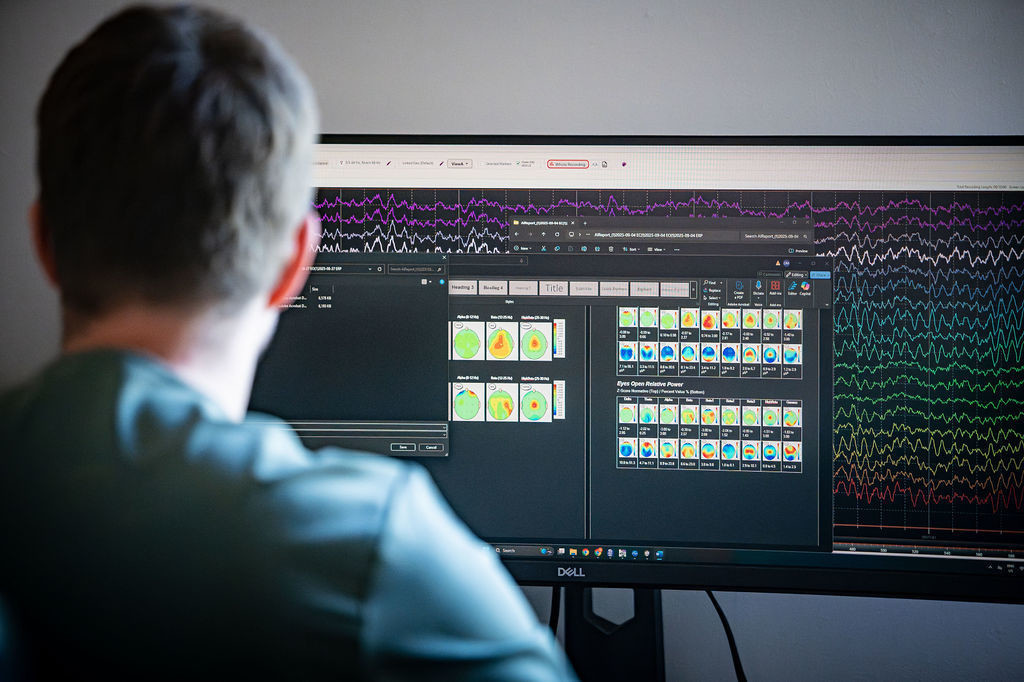
Neurofeedback for Treating Post-Traumatic Stress Disorder:
Post-traumatic stress disorder (PTSD) affects millions worldwide, with traditional treatments often falling short for many patients who experience treatment resistance or high dropout rates [1]. Neurofeedback, a non-invasive brain training technique that allows individuals to self-regulate their neural activity through real-time feedback, has emerged as a promising therapeutic intervention for PTSD [2]. This comprehensive review examines the current state of peer-reviewed research on neurofeedback interventions for PTSD, analyzing treatment mechanisms, clinical outcomes, methodological considerations, and future directions.
Understanding PTSD Neurobiology and Treatment Rationale
PTSD is characterized by significant alterations in brain network functioning, particularly within the default mode network (DMN), salience network (SN), and central executive network (CEN) [3]. Individuals with PTSD demonstrate disrupted patterns of brain connectivity that affect emotional regulation, threat detection, and cognitive processing [4]. Electroencephalographic studies consistently reveal dysfunctional brainwave patterns in PTSD, including reduced relative power of alpha rhythms and elevated beta activity, which correlate with hypervigilance, chronic hyperarousal, and sensory disinhibition [2].
These neurobiological alterations provide the theoretical foundation for neurofeedback interventions, which aim to directly target and modulate dysregulated brain activity patterns [5]. The underlying premise is that PTSD involves functional alterations rather than fundamental structural damage, making the brain amenable to retraining through neuroplasticity-based approaches [6].
Meta-Analytic Evidence and Systematic Reviews
Comprehensive Meta-Analyses
The most comprehensive systematic review and meta-analysis to date, conducted by researchers and published in 2023, analyzed ten clinical trials involving 293 participants (128 male) [2]. The meta-analysis of seven randomized controlled trials (RCTs) with 215 participants demonstrated a significant reduction in PTSD symptoms post-treatment with a standardized mean difference (SMD) of -1.76 (95% CI -2.69, -0.83) [2]. This represents a large effect size comparable to gold-standard PTSD treatments [2].
A subsequent 2024 meta-analysis examined 17 studies involving 628 patients and found consistent evidence supporting neurofeedback's effectiveness across multiple outcome measures [7]. The analysis revealed significant improvements in Beck Depression Inventory scores, CAPS-5 assessments, and PCL-5 measurements, with effect sizes increasing at follow-up periods[7]. The remission rate across studies was notably high, with 79.3% of neurofeedback participants achieving clinically meaningful improvement compared to 24.4% in control groups [2].
Treatment Efficacy Across Populations
A focused meta-analysis by researchers in 2023 specifically examined neurofeedback effectiveness across diverse trauma populations [8]. The analysis of ten articles comprising 276 participants yielded an SMD of -0.74 with moderate effect size and demonstrated that neurofeedback was particularly effective for complex trauma PTSD patients compared to single-trauma presentations [8]. The study also found that increasing session frequency and duration enhanced treatment effectiveness [8].
Types of Neurofeedback Interventions
EEG-Based Neurofeedback Protocols
Alpha Desynchronization Training
The most extensively studied EEG neurofeedback approach for PTSD involves alpha desynchronization protocols targeting the restoration of normal alpha rhythm patterns [9]. A landmark double-blind, randomized controlled trial conducted over 20 sessions demonstrated significant PTSD symptom reduction with 60% of participants no longer meeting diagnostic criteria at three-month follow-up [9]. The study uniquely tracked aberrant PTSD brain rhythms before and after treatment, providing evidence for an "alpha rebound effect" where normalized alpha power was restored predominantly within the anterior portion of the default mode network [9].
The neurobiological mechanism underlying alpha-based neurofeedback appears to involve homeostatic normalization of brain rhythms within key networks affected by trauma [9]. Participants showed resynchronization of alpha power over right dorsomedial prefrontal cortex areas, with spatial overlap between baseline abnormalities and regions demonstrating therapeutic improvement [9].
Comprehensive EEG Protocols
Van der Kolk and colleagues conducted a seminal randomized controlled trial involving 52 individuals with chronic PTSD who had not responded to at least six months of trauma-focused psychotherapy [10]. The study utilized 24 sessions of EEG neurofeedback training with sequential electrode placement (T4 active site, P4 reference) and demonstrated remarkable outcomes [10]. Post-treatment, only 27.3% of neurofeedback participants met PTSD criteria compared to 68.2% in the waitlist control group [10]. The effect sizes (d = -2.33 within-group, d = -1.71 between-group) were comparable to the most effective evidence-based PTSD treatments [10].
Alpha-Theta Training
Alpha-theta neurofeedback represents a specialized approach targeting the transition between alpha (8-12 Hz) and theta (4-8 Hz) brainwave states to facilitate emotional processing and trauma resolution [11]. A controlled clinical trial by Noohi and colleagues examined 30 male PTSD patients in Kermanshah City, Iran, who were randomly assigned to experimental (n=15) and control (n=15) groups [11]. The experimental group received 25 sessions of alpha/theta neurofeedback training, each lasting 30-40 minutes, four times per week [11]. This protocol aims to increase the ratio of theta waves (4-8 Hz) in mid and frontal brain areas relative to alpha waves (8-12 Hz), encouraging a shift into lower arousal states that is particularly indicated for individuals with PTSD [11]. The training aims to achieve “crossover” states where theta amplitudes exceed alpha amplitudes, facilitating access to emotionally charged memories without overwhelming activation [11]. Results demonstrated significant improvements in both PTSD symptoms and executive functioning measures, with participants showing enhanced performance on reasoning, planning, and problem-solving tasks as measured by the Tower of London test [11]. The study found that during predominant theta wave states, individuals experienced reduced anxiety and stimulation when re-experiencing traumatic events, suggesting that strengthening theta wave activity shifts attention inward and potentially reduces defensive mechanisms such as denial and avoidance [11].
Functional MRI Neurofeedback
Amygdala-Targeted Interventions
Real-time fMRI neurofeedback targeting amygdala downregulation has shown promise for PTSD treatment, given the amygdala's central role in fear processing and its hyperactivation in PTSD [12]. A double-blind, randomized clinical trial involving 25 PTSD patients examined three sessions of amygdala neurofeedback training using personalized trauma scripts [12]. The active group (n=14) received feedback from functionally localized amygdala regions, while controls (n=11) received yoked-sham feedback [12].
Results demonstrated significantly greater improvements in amygdala control in the active group 30 days post-intervention [12]. Patients successfully downregulated both right and left amygdala activation, with sustained effects observed in transfer runs without neurofeedback [13]. The intervention was associated with increased activation in dorsolateral and ventrolateral prefrontal cortex regions involved in emotion regulation [13].
Posterior Cingulate Cortex Targeting
A comparative pilot study examined differential effects of targeting the posterior cingulate cortex (PCC) versus amygdala in 28 PTSD participants [14]. PCC-targeted neurofeedback was associated with decreased neural activity in regions implicated in PTSD psychopathology, including bilateral cuneus/precuneus, superior parietal lobule, and temporoparietal junction [14]. Interestingly, PCC downregulation was differentially associated with reduced state PTSD symptoms compared to amygdala targeting [14].
Decoded Neurofeedback (DecNef)
Decoded neurofeedback represents an innovative approach utilizing multivariate pattern analysis to target specific neural representations associated with fear memories [15]. Unlike conventional neurofeedback that relies on averaged signals within brain regions, DecNef allows implicit regulation of multivariate voxel patterns related to feared stimuli [15]. Preliminary results from four PTSD patients showed significant symptom reduction comparable to conventional neurofeedback approaches [15]. Mathematical modeling suggested that exposure is the key component underlying DecNef effectiveness in fear reduction [15].
Specialized Populations and Applications
Pediatric and Adolescent Applications
Neurofeedback has demonstrated particular promise for children and adolescents with developmental trauma histories [17]. A randomized controlled study of 37 children aged 6-13 years with severe abuse and neglect histories compared 24 sessions of active neurofeedback (n=20) to treatment-as-usual controls (n=17) [17]. The active group showed significant decreases in PTSD symptoms, internalizing and externalizing behaviors, and improved executive functioning [17]. Notably, these were children who had not significantly benefited from previous therapeutic interventions [17].
Quantitative EEG research in adolescents with complex childhood trauma has identified distinct neuromarkers, including reduced total EEG power and modified alpha dynamics [18]. These findings support the rationale for neurofeedback interventions targeting dysregulated brain rhythms in developmental trauma populations [18].
Military and Veteran Populations
Mobile neurofeedback applications have shown particular promise for veteran populations with comorbid conditions [19]. A study of 41 veterans with chronic pain, traumatic brain injury, and PTSD examined portable EEG neurofeedback delivered via mobile devices over three months [19]. Participants completed an average of 33 sessions and demonstrated reduced pain intensity, depression, PTSD symptoms, anger, and sleep disturbance [19]. The 88% retention rate and absence of serious adverse events highlighted the feasibility and tolerability of home-based neurofeedback [19].
Treatment-Resistant Populations
Neurofeedback appears particularly valuable for treatment-resistant PTSD populations who have not responded to conventional interventions [10]. The van der Kolk study specifically recruited multiply traumatized individuals who had not improved with at least six months of trauma-focused psychotherapy [10]. The 72.7% remission rate in this challenging population exceeded outcomes typically reported for evidence-based PTSD treatments [10].
Treatment Mechanisms and Neural Changes
Brain Network Modulation
Neurofeedback interventions consistently demonstrate restoration of normal connectivity patterns within key brain networks affected by trauma [4][20]. Alpha desynchronization training specifically targets the default mode network and salience network, with successful treatment associated with normalization of connectivity patterns between these networks [9]. Participants show decreased hyperactivation in threat-detection networks and improved functional connectivity during rest states [20].
The salience network, responsible for detecting and directing neural resources toward threatening stimuli, shows normalization following neurofeedback training [20]. Similarly, the default mode network, involved in self-referential processing and autobiographical memory, demonstrates restored functional connectivity patterns [20]. These network-level changes correlate with symptom improvement and enhanced emotional regulation capacity [9].
Neuroplasticity and Learning Mechanisms
Neurofeedback operates through operant conditioning principles, enabling patients to learn voluntary control over brain activity patterns [2]. The training capitalizes on the brain's inherent neuroplasticity, allowing functional reorganization of neural circuits involved in emotional regulation and threat processing [6]. A systematic review of 18 studies found that infra-low frequency neurofeedback training operates on frequencies below 0.1 Hz and demonstrates significant potential to influence brain activity and neurovegetative parameters, with research indicating these frequencies play a higher-order role in the self-organization and regulation of the central nervous system [20].
The learning process involves both top-down and bottom-up information flow between prefrontal regulatory regions and subcortical emotional processing centers [13]. Dynamic causal modeling analyses suggest that successful amygdala downregulation involves bidirectional connectivity changes with prefrontal regions during regulation attempts [13].
Sustained Treatment Effects
A particularly noteworthy finding across neurofeedback studies is the pattern of continued improvement following treatment completion [2]. Unlike many interventions where benefits plateau or decline post-treatment, neurofeedback demonstrates sustained and sometimes increasing benefits at follow-up assessments [7]. This pattern suggests that neurofeedback induces lasting neuroplastic changes that continue to benefit patients beyond the active treatment period [2].
Clinical Protocols and Treatment Parameters
Session Structure and Duration
Neurofeedback protocols vary considerably across studies in terms of session frequency, duration, and total treatment length [2]. The most successful protocols typically involve 20-24 sessions delivered over 8-20 weeks [9][10]. Weekly sessions of 20-30 minutes duration appear optimal for EEG-based approaches, while fMRI neurofeedback studies have utilized shorter protocols of 2-3 sessions with promising results [12].
The alpha desynchronization protocol developed by Nicholson and colleagues utilized 20 weekly sessions with participants learning to reduce alpha rhythm intensity through individualized strategies [9]. Success was measured by visual feedback showing cartoon animations or image clarity that improved with successful alpha reduction [20]. Participants developed personalized approaches including mind-wandering, positive thinking, or focused attention [20].
Individualized vs. Standardized Approaches
ILF training targets the brain's hierarchy of regulation, prioritizing stability and arousal regulation through right hemisphere access points [6]. Research demonstrates that the effectiveness of ILF neurofeedback is significantly correlated with individualization of protocols, with studies showing that therapeutic effectiveness increases when treatments are tailored to each individual’s unique nervous system characteristics rather than using standardized approaches [21]. Clinical trials have shown that individualized neurofeedback protocols based on optimal response frequency (ORF) discovery produce superior treatment outcomes, with the search for individual ORFs across the broader EEG spectrum leading to entry into the infra-low frequency regime below 0.1 Hz [21].
Treatment Outcomes and Clinical Effectiveness
Symptom Reduction and Remission Rates
Neurofeedback consistently demonstrates clinically meaningful symptom reduction across multiple PTSD symptom domains [2]. Meta-analytic evidence shows remission rates of 60-80% across studies, with many participants no longer meeting diagnostic criteria for PTSD at follow-up [2][9]. These outcomes are comparable to or exceed those reported for established evidence-based treatments [10].
The Western University study demonstrated a 61.1% remission rate at post-treatment, with no participant dropouts throughout the 20-week protocol [20]. This exceptional retention rate contrasts favorably with traditional PTSD treatments, which typically experience 18% average dropout rates [1]. The combination of high efficacy and excellent tolerability positions neurofeedback as a particularly valuable treatment option [24].
Secondary Symptom Improvements
Beyond core PTSD symptoms, neurofeedback demonstrates significant benefits for commonly comorbid conditions including depression, anxiety, sleep disturbances, and cognitive functioning [2][7]. The Chinese randomized controlled trial showed improvements across all five cognitive dimensions assessed by neuropsychological testing, with changes significantly correlated with PTSD symptom reduction [2].
Veterans receiving mobile neurofeedback showed decreased pain intensity, anger, sleep disturbance, and suicidal ideation in addition to PTSD symptom reduction [19]. Children with developmental trauma demonstrated improvements in executive functioning, attention, and behavioral regulation [17]. These broad benefits suggest that neurofeedback addresses fundamental regulatory capacities underlying multiple symptom domains [6].
Comparative Effectiveness
Direct comparisons between neurofeedback and established treatments are limited, though available evidence suggests comparable or superior outcomes [10]. The van der Kolk study effect sizes (d = -2.33 within-group, d = -1.71 between-group) matched or exceeded those reported for prolonged exposure, cognitive behavioral therapy, and EMDR [10]. Importantly, these outcomes were achieved in treatment-resistant populations who had not responded to conventional trauma-focused psychotherapy [10].
Low-cost, wearable EEG neurofeedback has produced promising results comparable to traditional approaches while offering improved accessibility [25]. A study conducted in Rwanda demonstrated significant PTSD symptom reduction using portable neurofeedback technology, providing the first evidence for cost-effective neurotechnological solutions in resource-limited settings [25].
Safety Profile and Tolerability
Adverse Events and Side Effects
Neurofeedback demonstrates a favorable safety profile with minimal reported adverse events across clinical trials, with systematic reviews indicating that interventions are well tolerated with only limited studies reporting side effects [26]. The most commonly reported side effects in controlled studies are mild and temporary, including headaches, fatigue, nausea, and drowsiness, which generally do not lead to withdrawal from therapy except in rare cases [27]. A randomized controlled study of healthy volunteers found that most participants reported experiencing some transient adverse effects, with the most frequent being temporary intensification of previously problematic symptoms such as pressure in the head, dizziness, or physical discomfort, typically occurring within the first six or seven sessions and resolving within a few days [28]. Clinical trials consistently report that emotional responses such as temporary irritability or heightened sensitivity may occur but are typically short-lived, with fatigue and restlessness being the most common indications of overtreatment that can be managed by adjusting session parameters [26][28].
In the van der Kolk study involving treatment-resistant PTSD patients, only one participant (4%) reported significant side effects consisting of increased flashbacks [10]. No serious adverse events have been reported across major neurofeedback trials, and dropout rates due to side effects are exceptionally low [2]. The excellent tolerability profile makes neurofeedback particularly suitable for individuals who experience side effects from psychotropic medications or struggle with the emotional intensity of exposure-based therapies [6].
Contraindications and Precautions
While generally safe, certain populations (e.g. individuals with epilepsy or severe psychiatric disorders) may require additional consideration when implementing neurofeedback interventions [26]. However, no absolute contraindications exist, and neurofeedback has been successfully implemented across diverse populations including children, veterans, and individuals with complex trauma histories [17] [19].
The non-invasive nature of neurofeedback makes it particularly suitable for populations who may not tolerate conventional treatments [6]. Unlike pharmacological interventions, neurofeedback does not involve systemic side effects or withdrawal concerns, making it an attractive option for individuals seeking non-medication approaches [6].
Methodological Considerations and Limitations
Research Quality and Study Design
While neurofeedback shows consistent promise across studies, methodological limitations affect the strength of current evidence [2]. Most studies involve relatively small sample sizes, and heterogeneity in treatment protocols makes direct comparisons challenging [2]. The 2023 meta-analysis noted very low certainty of evidence despite significant effect sizes, highlighting the need for larger, more methodologically rigorous trials[2].
However, recent studies have incorporated improved designs including double-blind controls, active sham conditions, and longer follow-up periods [9] [12]. The alpha desynchronization study by Nicholson and colleagues represents a methodological advancement with its double-blind, randomized design and concurrent tracking of neurophysiological changes [9]. Similarly, the amygdala neurofeedback study utilized rigorous double-blind procedures with yoked-sham controls [12].
Protocol Standardization Challenges
A significant limitation in the field is the lack of standardized treatment protocols, with different studies employing varying neurofeedback parameters, session frequencies, and electrode placements [2]. This heterogeneity complicates meta-analytic synthesis and clinical implementation[2]. However, emerging evidence suggests that certain approaches, particularly alpha-based protocols and amygdala targeting, show consistent benefits across multiple investigations[2][12].
The development of manualized protocols and standardized training procedures represents an important next step for clinical implementation [6]. The EEG Institute's development of individualized ILF protocols based on optimal response frequency represents one approach to standardization while maintaining personalization [21].
Future Research Directions and Clinical Implications
Mechanistic Understanding
Future research should focus on clarifying the specific mechanisms by which neurofeedback produces therapeutic benefits in PTSD [2]. This includes investigating the relationship between successful neural regulation during training sessions and subsequent symptom improvement, as well as identifying optimal brain targets for different PTSD presentations [5]. Advanced neuroimaging techniques combined with real-time feedback offer opportunities to better understand treatment mechanisms [15]
Research demonstrates that individualized neurofeedback protocols based on quantitative EEG analyses and symptom-specific brain biomarkers show superior treatment outcomes, with studies indicating that personalized approaches can transform non-responders into responders by adapting protocols to meet unique neurophysiological and psychological profiles of each individual [22][23]. Resting-state connectivity patterns and quantitative EEG abnormalities may serve as biomarkers for treatment selection and outcome prediction [18].
Large-Scale Clinical Trials
The field urgently needs larger, well-powered randomized controlled trials with appropriate control conditions and longer follow-up periods[2]. Such studies should compare neurofeedback directly to established treatments and examine its effectiveness as both standalone and adjunctive interventions [7]. Multi-site trials would enable investigation of protocol generalizability and clinician training requirements[2].
Cost-effectiveness analyses are also needed to support clinical implementation and healthcare policy decisions[2]. The potential for home-based and mobile neurofeedback delivery offers opportunities for scalable, accessible treatment models [19][25].
Clinical Implementation and Recommendations
Based on current evidence, neurofeedback appears to be a promising adjunctive or alternative treatment for PTSD, particularly for individuals who have not responded adequately to conventional interventions [10]. The technique may be especially valuable for treatment-resistant patients, those who experience significant side effects from medications, or individuals who prefer non-pharmacological approaches [6].
Clinicians considering neurofeedback should ensure adequate training in specific protocols and maintain awareness of individual contraindications. The excellent safety profile and high patient tolerability make neurofeedback suitable for diverse populations, though specialized training may be beneficial for complex presentations [17].
The evidence strongly supports neurofeedback as an effective intervention for PTSD, with effect sizes comparable to established treatments and superior tolerability profiles [2][10]. As research methodology continues to improve and protocols become standardized, neurofeedback is likely to emerge as a valuable addition to the therapeutic armamentarium for trauma-related disorders [29]. The field shows particular promise for addressing the significant treatment gaps that exist for individuals with complex, treatment-resistant PTSD presentations [8].






